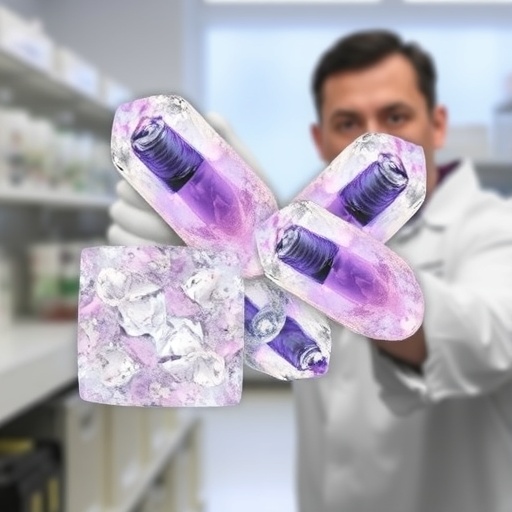In a groundbreaking leap bridging the realms of chemistry, materials science, and pharmaceutical technology, researchers at the University of Houston have unveiled a novel method to induce bending and twisting in biogenic crystals without the application of external force. Led by Jeffrey Rimer, the Abraham E. Dukler Professor of Chemical Energy, this research leverages the subtle molecular dynamics of tautomerism to manipulate crystal morphology, a feat previously thought to require mechanical intervention or environmental stressors such as heat or radiation.
Rimer’s investigation overturns conventional paradigms in crystallography by demonstrating that natural bending and twisting in crystals can be induced purely through the internal molecular rearrangements of tautomers, a class of molecules capable of rapid atomic shuffling. These tautomers exhibit the remarkable ability to reposition hydrogen atoms and adjust their atomic configurations spontaneously, introducing localized defects in the crystal lattice that manifest in macro-scale curvature without external manipulation.
The implications of this discovery resonate profoundly within the pharmaceutical industry, where about 30 of the top 200 drugs are composed of tautomeric molecules. The team’s insights suggest that by understanding and controlling tautomer-induced defects, it may be possible to tailor drug delivery mechanisms with unprecedented precision. Alterations in crystal shape and morphology directly influence dissolution rates, drug bioavailability, and pharmacokinetics, potentially revolutionizing how active pharmaceutical ingredients are formulated for enhanced therapeutic performance.
This breakthrough was meticulously detailed in the latest edition of the Proceedings of the National Academy of Sciences, where Rimer and his collaborators presented compelling evidence of natural, controlled bending arising from the formation of crystal defects such as twins, screw, and edge dislocations. Such defects emerge as a byproduct of the minor tautomer’s role as a growth modifier during crystallization, underscoring the nuanced interplay between molecular chemistry and crystal plasticity.
At the heart of this research lies an innovative approach combining state-of-the-art microscopic and spectroscopic techniques, which allowed the team to visualize and quantify the structural changes within the crystals at multiple length scales. By fine-tuning growth conditions, the researchers demonstrated the ability to modulate the extent of curvature, paving the way for engineered crystals with customized shapes and mechanical properties.
The significance of bending and twisting molecular crystals extends beyond pharmaceuticals, with potential applications spanning optoelectronics, soft robotics, and smart sensors. Materials engineered for flexibility and dynamic response could lead to the next generation of adaptive electronics and responsive biomaterials, where mechanical deformation plays a critical role in function and efficiency.
Rimer emphasizes that this mechanistic understanding offers a gateway to crystal engineering strategies that harness naturally occurring molecular phenomena for precise material design. By exploiting tautomerism-induced defects, scientists may develop novel pathways for fabricating crystals with complex morphologies unattainable through traditional methods reliant on physical deformation or external forces.
Moreover, the research reveals new insights into pathological crystallization, shedding light on how defects generated through minor tautomer populations might influence the formation of unique crystal morphologies observed both in synthetic environments and biological systems. This cross-disciplinary revelation opens a frontier where chemistry meets biology, deepening our comprehension of growth processes that dictate material properties on a fundamental level.
The pioneering work is supported by the Welch Center for Advanced Bioactive Materials Crystallization, a research hub established at the University of Houston in 2023 with a generous $5 million grant from the Welch Foundation. This center not only fosters cutting-edge investigations like Rimer’s but also facilitates collaboration across institutions and industry partnerships, anchoring Texas as a forefront of chemical research excellence.
Recent initiatives by the Welch Center, including symposia featuring an industrial advisory board created by major pharmaceutical players and summer crystallization camps for budding scientists, underscore a commitment to nurturing the next generation of innovators in materials science and drug development.
The ability to control crystal morphology through tautomerism challenges longstanding notions in condensed matter physics and crystallography. By manipulating atomic rearrangements and crystal plasticity at the molecular level, Jeffery Rimer’s research establishes a compelling platform for future explorations into adaptive materials and transformative pharmaceutical technologies.
This remarkable work charts a new course for the science of crystals, illustrating that molecular gymnastics within the crystal lattice constitute a hidden arsenal for material engineers seeking to introduce flexibility, sophistication, and functionality into traditionally rigid structures. The marriage of tautomer chemistry with crystal growth dynamics thus heralds a paradigm shift with implications rippling across applied sciences and healthcare.
Subject of Research: Tautomerism-induced natural bending and twisting in biogenic crystals and its applications in material science and pharmaceuticals.
Article Title: Tautomerism induces bending and twisting of biogenic crystals
References: Reported in the journal Proceedings of the National Academy of Sciences (PNAS)
Image Credits: University of Houston
Tags: biogenic crystal manipulationcrystal formation controlcrystal morphology engineeringdrug delivery mechanisms innovationimpact of crystallography on pharmaceuticalsinternal molecular rearrangementslocalized defects in crystal latticesmolecular dynamics in materials sciencenon-mechanical crystal bendingpharmaceutical technology advancementstautomerism in chemistryUniversity of Houston research breakthroughs





